MGMT638: Ethical Leadership & Social Responsibility Report Analysis
VerifiedAdded on 2023/01/04
|10
|2796
|111
Report
AI Summary
This report presents an in-depth analysis of a case study focused on ethical leadership and social responsibility. The case examines the leadership styles of Marianne and Betsy within a college setting, highlighting the conflicts arising from their differing approaches. The report identifies and discusses various leadership theories, including team leadership, situational leadership, and the country club leadership approach. It further explores relevant models and frameworks such as effective teamwork and conflict management. The analysis delves into the specific case questions, evaluating the leadership styles of both Marianne and Betsy, suggesting improvements for their approaches, and emphasizing the need for unified leadership. The conclusion summarizes the key findings, emphasizing the importance of aligning leadership styles and fostering a collaborative environment for organizational success. The report underscores the significance of understanding and applying leadership theories to resolve workplace conflicts and enhance team performance, offering practical recommendations for effective leadership practices.
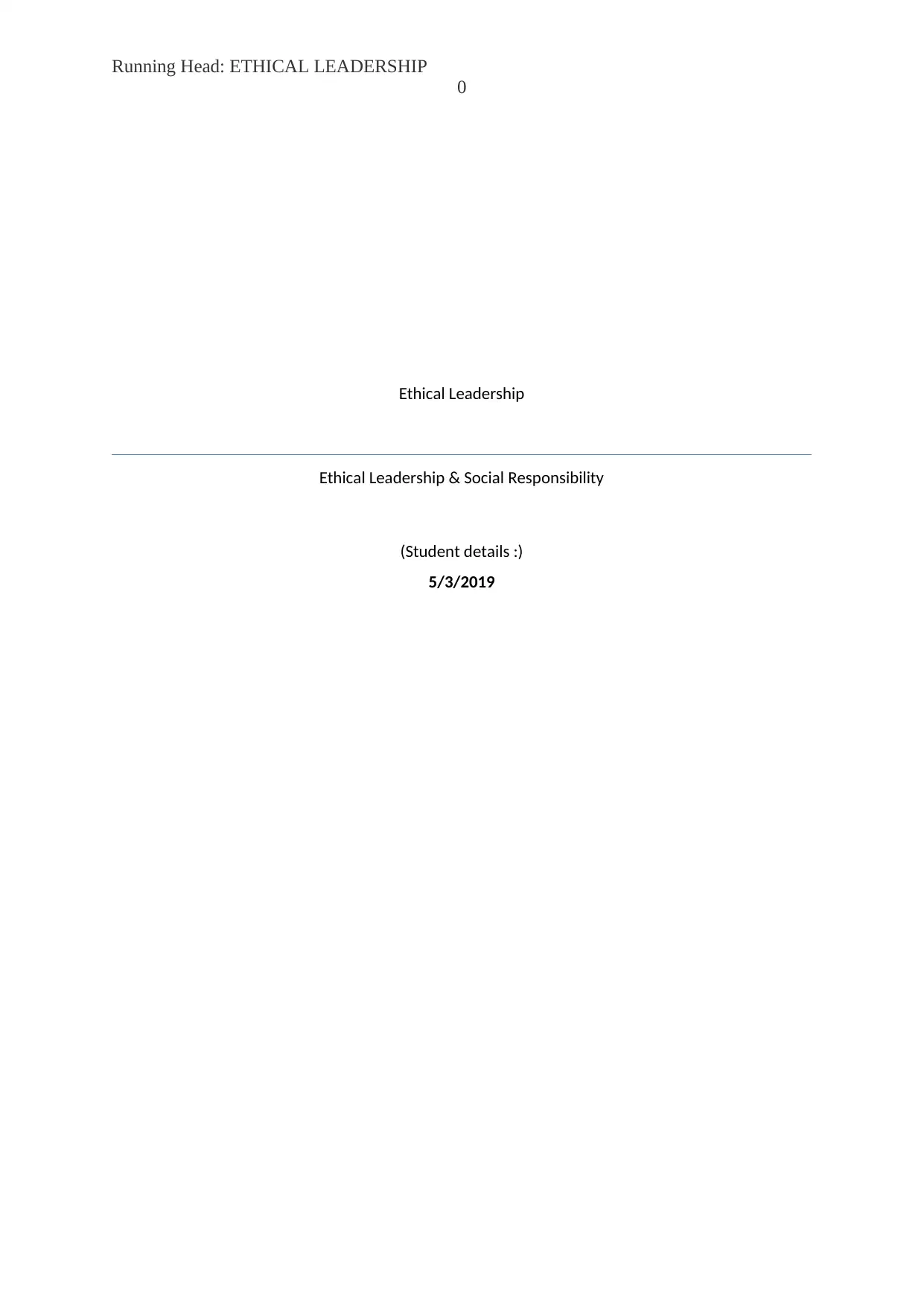
Running Head: ETHICAL LEADERSHIP
0
Ethical Leadership
Ethical Leadership & Social Responsibility
(Student details :)
5/3/2019
0
Ethical Leadership
Ethical Leadership & Social Responsibility
(Student details :)
5/3/2019
Paraphrase This Document
Need a fresh take? Get an instant paraphrase of this document with our AI Paraphraser
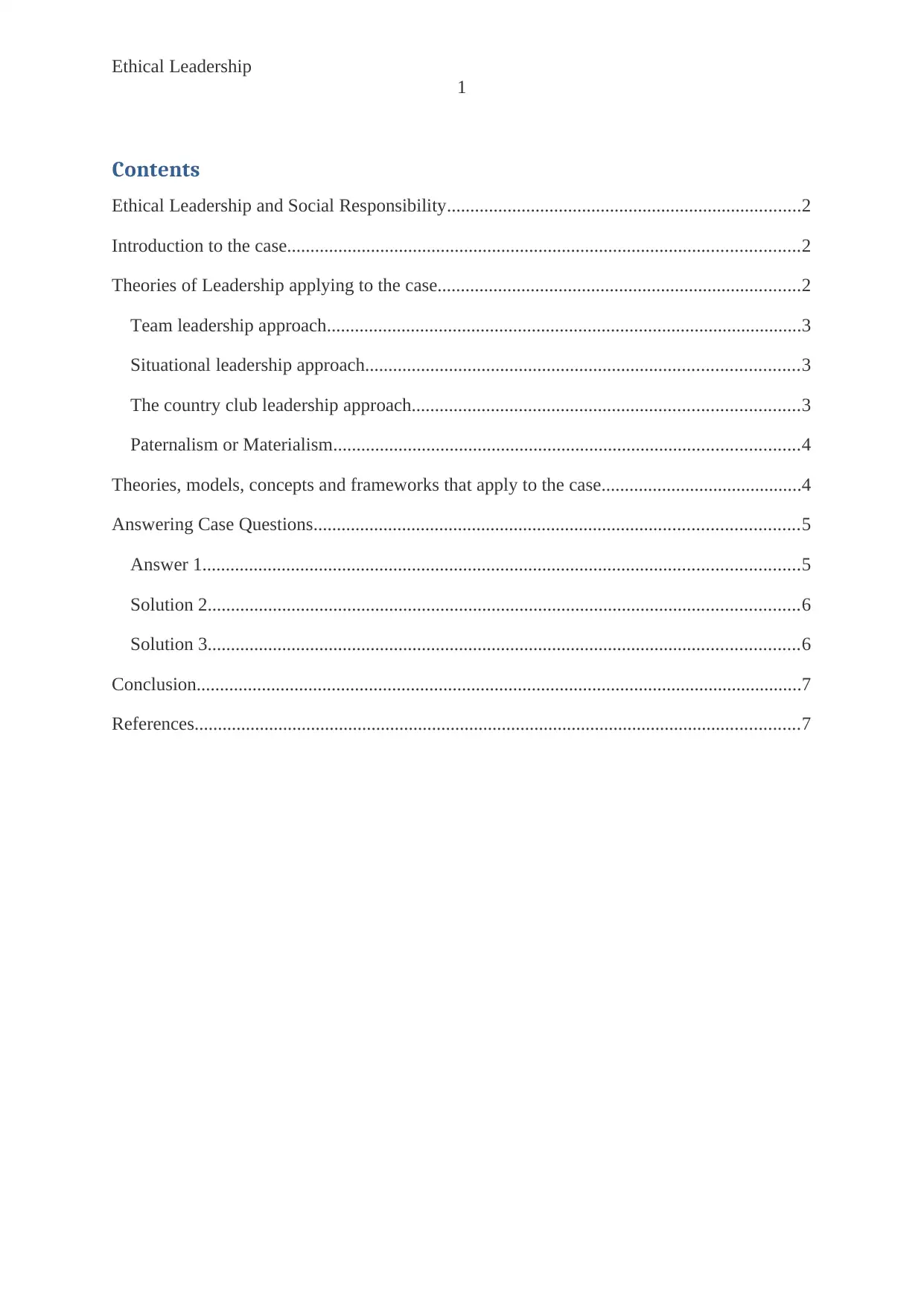
Ethical Leadership
1
Contents
Ethical Leadership and Social Responsibility............................................................................2
Introduction to the case..............................................................................................................2
Theories of Leadership applying to the case..............................................................................2
Team leadership approach......................................................................................................3
Situational leadership approach.............................................................................................3
The country club leadership approach...................................................................................3
Paternalism or Materialism....................................................................................................4
Theories, models, concepts and frameworks that apply to the case...........................................4
Answering Case Questions........................................................................................................5
Answer 1................................................................................................................................5
Solution 2...............................................................................................................................6
Solution 3...............................................................................................................................6
Conclusion..................................................................................................................................7
References..................................................................................................................................7
1
Contents
Ethical Leadership and Social Responsibility............................................................................2
Introduction to the case..............................................................................................................2
Theories of Leadership applying to the case..............................................................................2
Team leadership approach......................................................................................................3
Situational leadership approach.............................................................................................3
The country club leadership approach...................................................................................3
Paternalism or Materialism....................................................................................................4
Theories, models, concepts and frameworks that apply to the case...........................................4
Answering Case Questions........................................................................................................5
Answer 1................................................................................................................................5
Solution 2...............................................................................................................................6
Solution 3...............................................................................................................................6
Conclusion..................................................................................................................................7
References..................................................................................................................................7
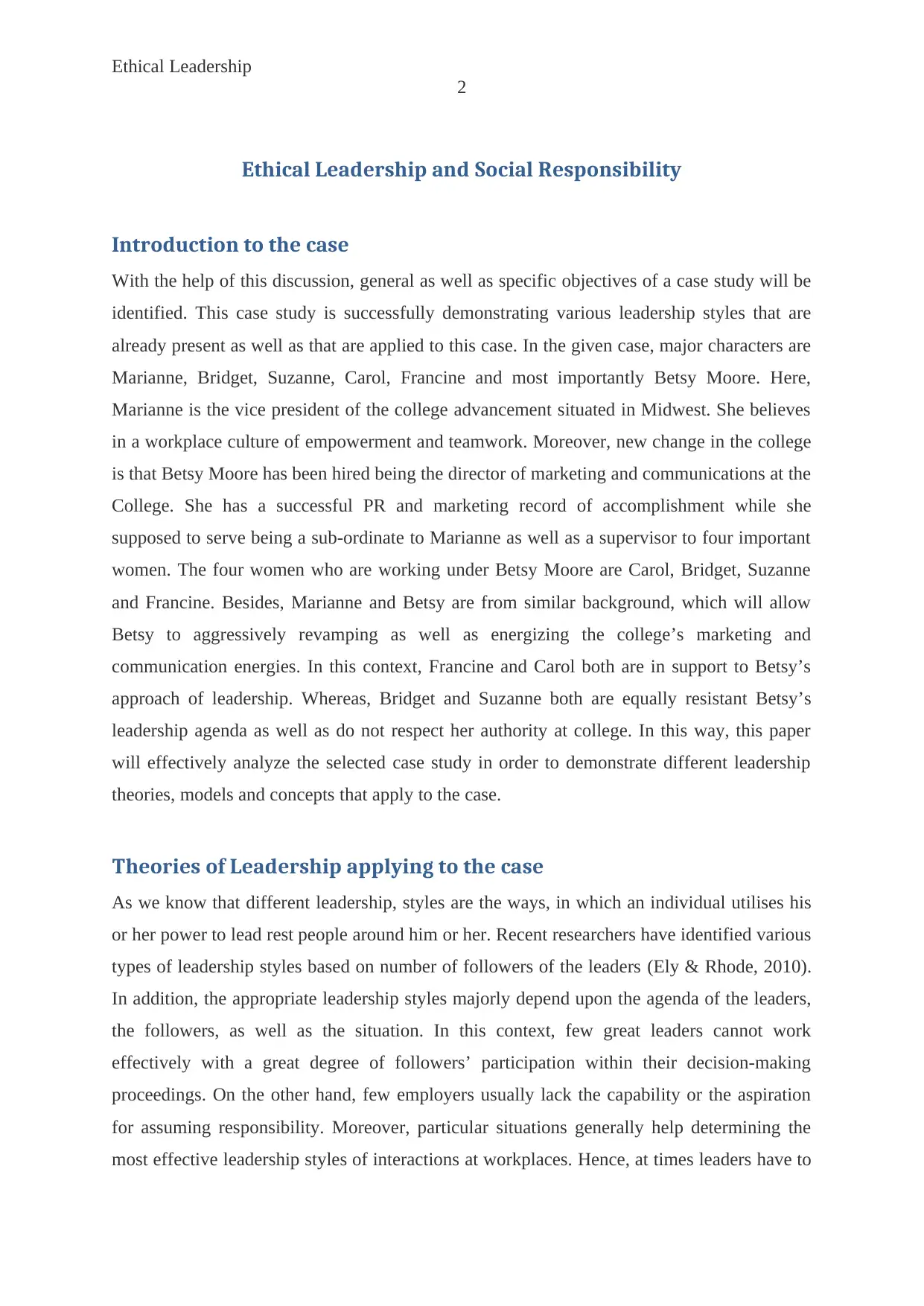
Ethical Leadership
2
Ethical Leadership and Social Responsibility
Introduction to the case
With the help of this discussion, general as well as specific objectives of a case study will be
identified. This case study is successfully demonstrating various leadership styles that are
already present as well as that are applied to this case. In the given case, major characters are
Marianne, Bridget, Suzanne, Carol, Francine and most importantly Betsy Moore. Here,
Marianne is the vice president of the college advancement situated in Midwest. She believes
in a workplace culture of empowerment and teamwork. Moreover, new change in the college
is that Betsy Moore has been hired being the director of marketing and communications at the
College. She has a successful PR and marketing record of accomplishment while she
supposed to serve being a sub-ordinate to Marianne as well as a supervisor to four important
women. The four women who are working under Betsy Moore are Carol, Bridget, Suzanne
and Francine. Besides, Marianne and Betsy are from similar background, which will allow
Betsy to aggressively revamping as well as energizing the college’s marketing and
communication energies. In this context, Francine and Carol both are in support to Betsy’s
approach of leadership. Whereas, Bridget and Suzanne both are equally resistant Betsy’s
leadership agenda as well as do not respect her authority at college. In this way, this paper
will effectively analyze the selected case study in order to demonstrate different leadership
theories, models and concepts that apply to the case.
Theories of Leadership applying to the case
As we know that different leadership, styles are the ways, in which an individual utilises his
or her power to lead rest people around him or her. Recent researchers have identified various
types of leadership styles based on number of followers of the leaders (Ely & Rhode, 2010).
In addition, the appropriate leadership styles majorly depend upon the agenda of the leaders,
the followers, as well as the situation. In this context, few great leaders cannot work
effectively with a great degree of followers’ participation within their decision-making
proceedings. On the other hand, few employers usually lack the capability or the aspiration
for assuming responsibility. Moreover, particular situations generally help determining the
most effective leadership styles of interactions at workplaces. Hence, at times leaders have to
2
Ethical Leadership and Social Responsibility
Introduction to the case
With the help of this discussion, general as well as specific objectives of a case study will be
identified. This case study is successfully demonstrating various leadership styles that are
already present as well as that are applied to this case. In the given case, major characters are
Marianne, Bridget, Suzanne, Carol, Francine and most importantly Betsy Moore. Here,
Marianne is the vice president of the college advancement situated in Midwest. She believes
in a workplace culture of empowerment and teamwork. Moreover, new change in the college
is that Betsy Moore has been hired being the director of marketing and communications at the
College. She has a successful PR and marketing record of accomplishment while she
supposed to serve being a sub-ordinate to Marianne as well as a supervisor to four important
women. The four women who are working under Betsy Moore are Carol, Bridget, Suzanne
and Francine. Besides, Marianne and Betsy are from similar background, which will allow
Betsy to aggressively revamping as well as energizing the college’s marketing and
communication energies. In this context, Francine and Carol both are in support to Betsy’s
approach of leadership. Whereas, Bridget and Suzanne both are equally resistant Betsy’s
leadership agenda as well as do not respect her authority at college. In this way, this paper
will effectively analyze the selected case study in order to demonstrate different leadership
theories, models and concepts that apply to the case.
Theories of Leadership applying to the case
As we know that different leadership, styles are the ways, in which an individual utilises his
or her power to lead rest people around him or her. Recent researchers have identified various
types of leadership styles based on number of followers of the leaders (Ely & Rhode, 2010).
In addition, the appropriate leadership styles majorly depend upon the agenda of the leaders,
the followers, as well as the situation. In this context, few great leaders cannot work
effectively with a great degree of followers’ participation within their decision-making
proceedings. On the other hand, few employers usually lack the capability or the aspiration
for assuming responsibility. Moreover, particular situations generally help determining the
most effective leadership styles of interactions at workplaces. Hence, at times leaders have to
⊘ This is a preview!⊘
Do you want full access?
Subscribe today to unlock all pages.

Trusted by 1+ million students worldwide
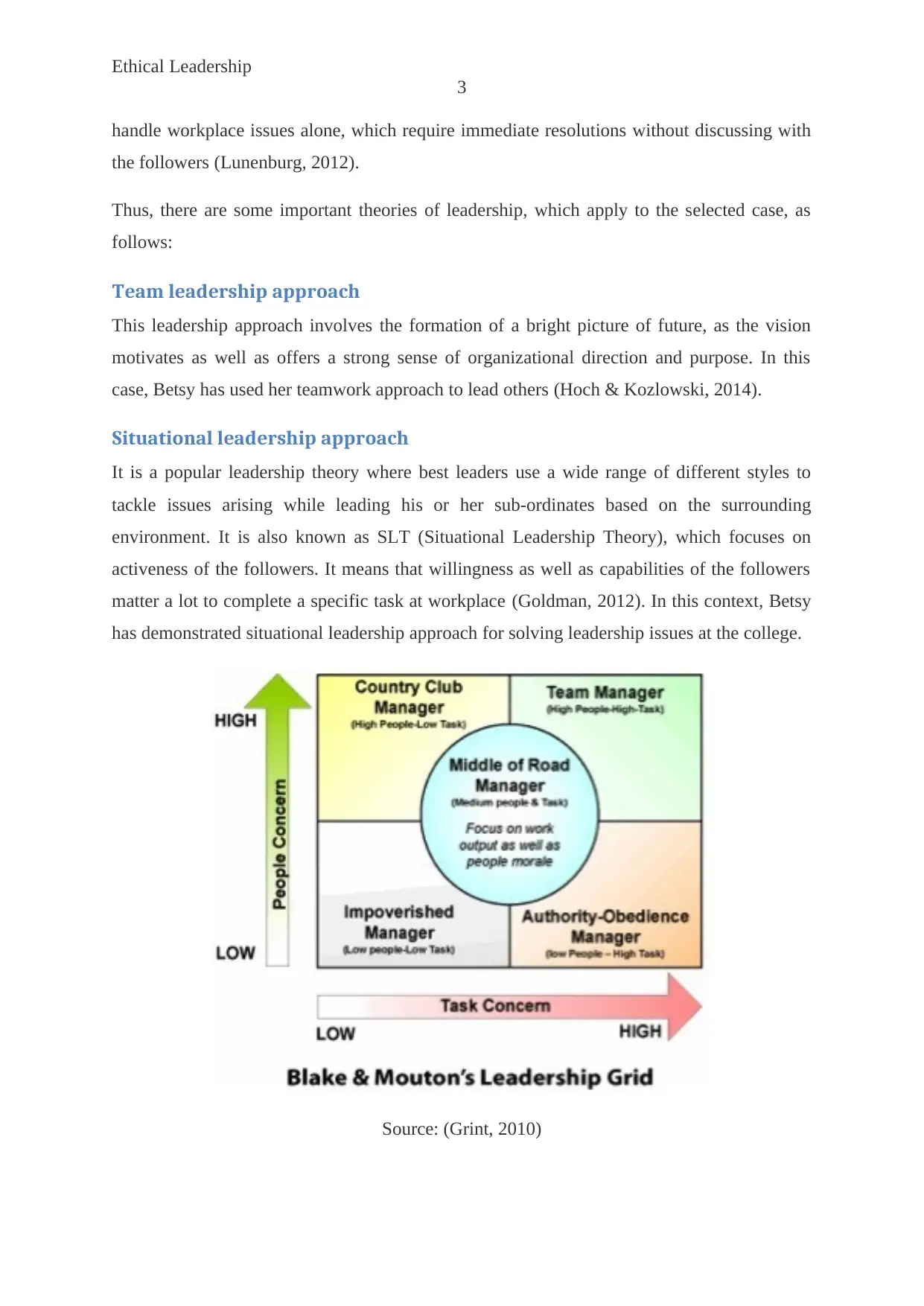
Ethical Leadership
3
handle workplace issues alone, which require immediate resolutions without discussing with
the followers (Lunenburg, 2012).
Thus, there are some important theories of leadership, which apply to the selected case, as
follows:
Team leadership approach
This leadership approach involves the formation of a bright picture of future, as the vision
motivates as well as offers a strong sense of organizational direction and purpose. In this
case, Betsy has used her teamwork approach to lead others (Hoch & Kozlowski, 2014).
Situational leadership approach
It is a popular leadership theory where best leaders use a wide range of different styles to
tackle issues arising while leading his or her sub-ordinates based on the surrounding
environment. It is also known as SLT (Situational Leadership Theory), which focuses on
activeness of the followers. It means that willingness as well as capabilities of the followers
matter a lot to complete a specific task at workplace (Goldman, 2012). In this context, Betsy
has demonstrated situational leadership approach for solving leadership issues at the college.
Source: (Grint, 2010)
3
handle workplace issues alone, which require immediate resolutions without discussing with
the followers (Lunenburg, 2012).
Thus, there are some important theories of leadership, which apply to the selected case, as
follows:
Team leadership approach
This leadership approach involves the formation of a bright picture of future, as the vision
motivates as well as offers a strong sense of organizational direction and purpose. In this
case, Betsy has used her teamwork approach to lead others (Hoch & Kozlowski, 2014).
Situational leadership approach
It is a popular leadership theory where best leaders use a wide range of different styles to
tackle issues arising while leading his or her sub-ordinates based on the surrounding
environment. It is also known as SLT (Situational Leadership Theory), which focuses on
activeness of the followers. It means that willingness as well as capabilities of the followers
matter a lot to complete a specific task at workplace (Goldman, 2012). In this context, Betsy
has demonstrated situational leadership approach for solving leadership issues at the college.
Source: (Grint, 2010)
Paraphrase This Document
Need a fresh take? Get an instant paraphrase of this document with our AI Paraphraser
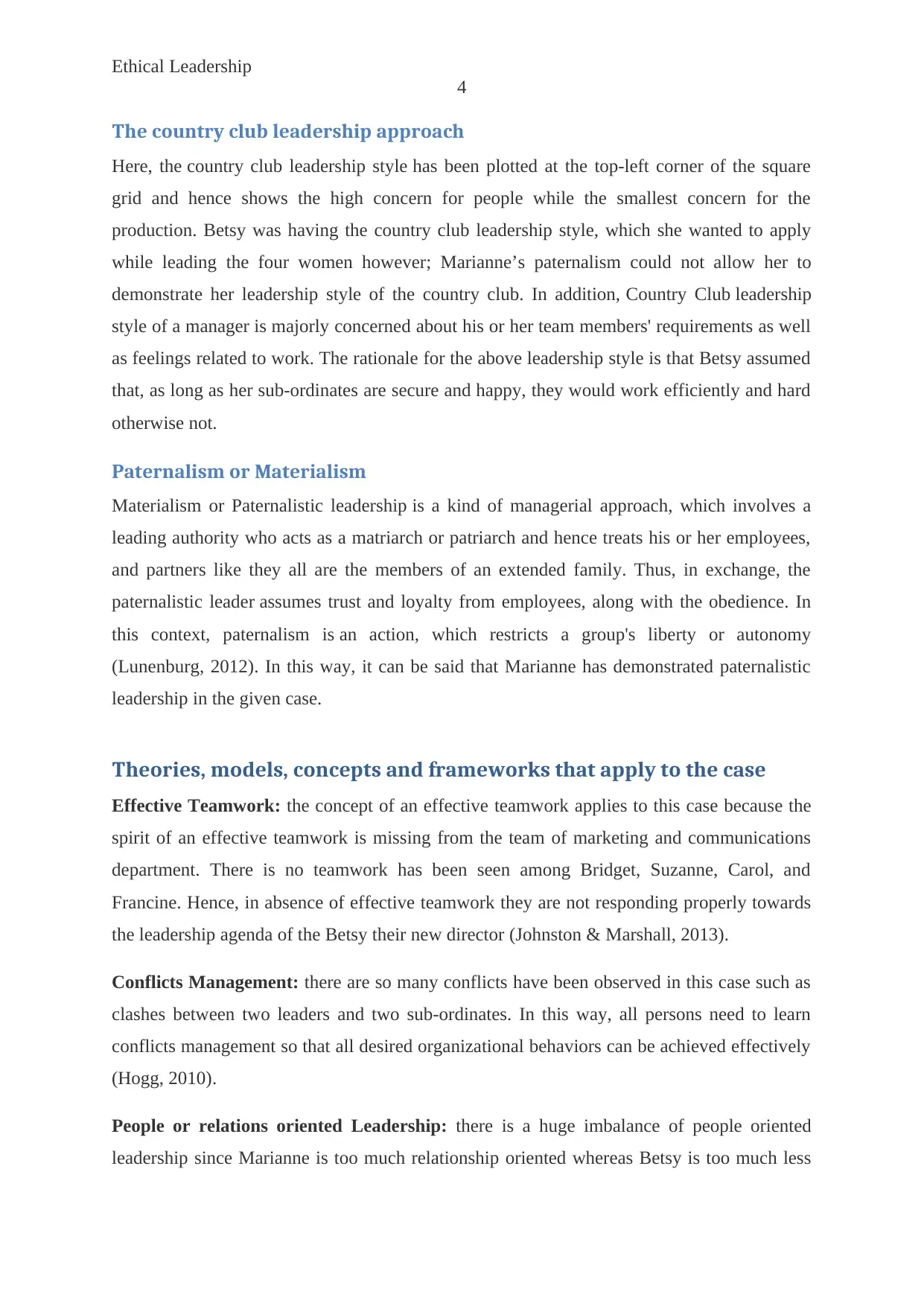
Ethical Leadership
4
The country club leadership approach
Here, the country club leadership style has been plotted at the top-left corner of the square
grid and hence shows the high concern for people while the smallest concern for the
production. Betsy was having the country club leadership style, which she wanted to apply
while leading the four women however; Marianne’s paternalism could not allow her to
demonstrate her leadership style of the country club. In addition, Country Club leadership
style of a manager is majorly concerned about his or her team members' requirements as well
as feelings related to work. The rationale for the above leadership style is that Betsy assumed
that, as long as her sub-ordinates are secure and happy, they would work efficiently and hard
otherwise not.
Paternalism or Materialism
Materialism or Paternalistic leadership is a kind of managerial approach, which involves a
leading authority who acts as a matriarch or patriarch and hence treats his or her employees,
and partners like they all are the members of an extended family. Thus, in exchange, the
paternalistic leader assumes trust and loyalty from employees, along with the obedience. In
this context, paternalism is an action, which restricts a group's liberty or autonomy
(Lunenburg, 2012). In this way, it can be said that Marianne has demonstrated paternalistic
leadership in the given case.
Theories, models, concepts and frameworks that apply to the case
Effective Teamwork: the concept of an effective teamwork applies to this case because the
spirit of an effective teamwork is missing from the team of marketing and communications
department. There is no teamwork has been seen among Bridget, Suzanne, Carol, and
Francine. Hence, in absence of effective teamwork they are not responding properly towards
the leadership agenda of the Betsy their new director (Johnston & Marshall, 2013).
Conflicts Management: there are so many conflicts have been observed in this case such as
clashes between two leaders and two sub-ordinates. In this way, all persons need to learn
conflicts management so that all desired organizational behaviors can be achieved effectively
(Hogg, 2010).
People or relations oriented Leadership: there is a huge imbalance of people oriented
leadership since Marianne is too much relationship oriented whereas Betsy is too much less
4
The country club leadership approach
Here, the country club leadership style has been plotted at the top-left corner of the square
grid and hence shows the high concern for people while the smallest concern for the
production. Betsy was having the country club leadership style, which she wanted to apply
while leading the four women however; Marianne’s paternalism could not allow her to
demonstrate her leadership style of the country club. In addition, Country Club leadership
style of a manager is majorly concerned about his or her team members' requirements as well
as feelings related to work. The rationale for the above leadership style is that Betsy assumed
that, as long as her sub-ordinates are secure and happy, they would work efficiently and hard
otherwise not.
Paternalism or Materialism
Materialism or Paternalistic leadership is a kind of managerial approach, which involves a
leading authority who acts as a matriarch or patriarch and hence treats his or her employees,
and partners like they all are the members of an extended family. Thus, in exchange, the
paternalistic leader assumes trust and loyalty from employees, along with the obedience. In
this context, paternalism is an action, which restricts a group's liberty or autonomy
(Lunenburg, 2012). In this way, it can be said that Marianne has demonstrated paternalistic
leadership in the given case.
Theories, models, concepts and frameworks that apply to the case
Effective Teamwork: the concept of an effective teamwork applies to this case because the
spirit of an effective teamwork is missing from the team of marketing and communications
department. There is no teamwork has been seen among Bridget, Suzanne, Carol, and
Francine. Hence, in absence of effective teamwork they are not responding properly towards
the leadership agenda of the Betsy their new director (Johnston & Marshall, 2013).
Conflicts Management: there are so many conflicts have been observed in this case such as
clashes between two leaders and two sub-ordinates. In this way, all persons need to learn
conflicts management so that all desired organizational behaviors can be achieved effectively
(Hogg, 2010).
People or relations oriented Leadership: there is a huge imbalance of people oriented
leadership since Marianne is too much relationship oriented whereas Betsy is too much less
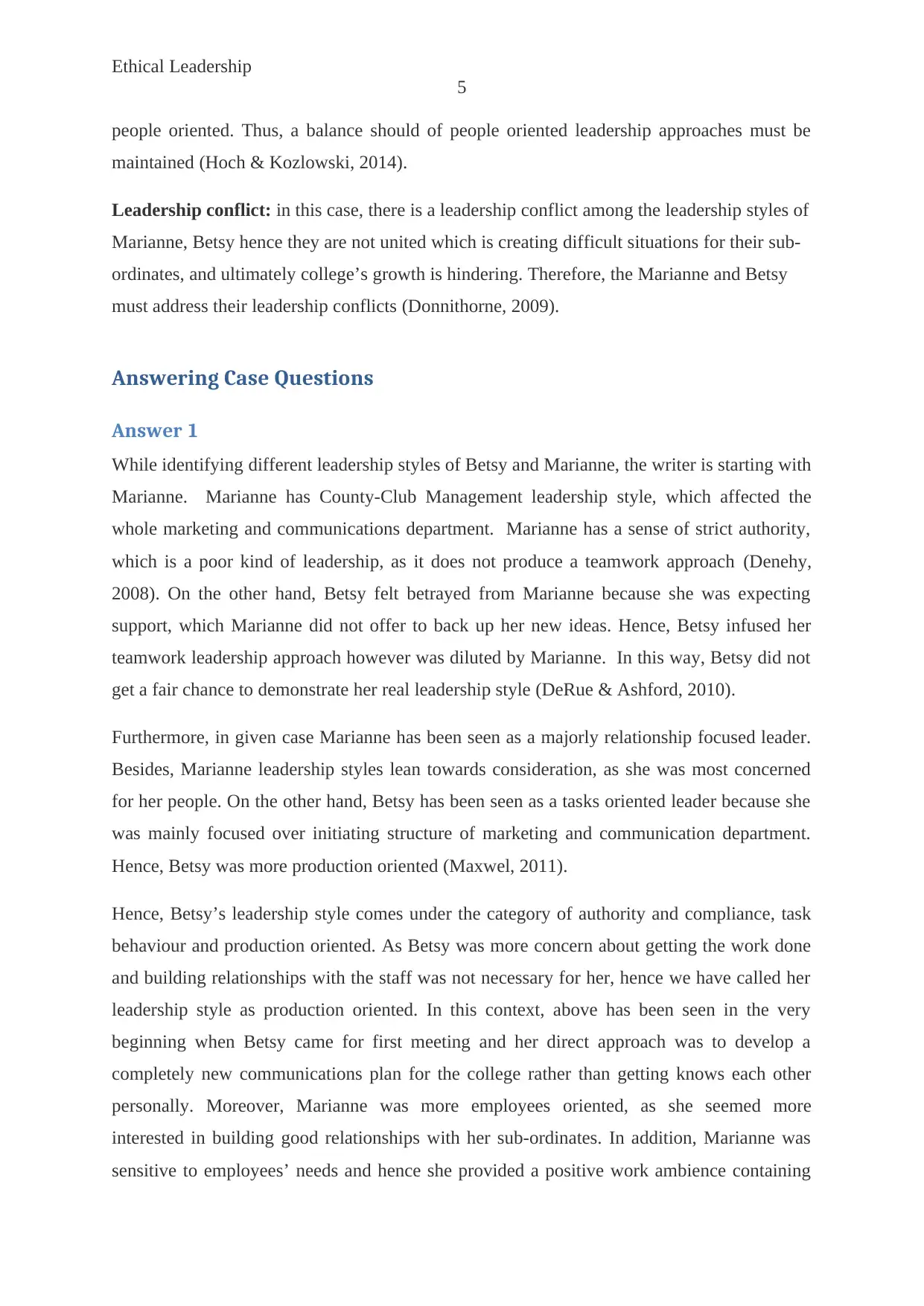
Ethical Leadership
5
people oriented. Thus, a balance should of people oriented leadership approaches must be
maintained (Hoch & Kozlowski, 2014).
Leadership conflict: in this case, there is a leadership conflict among the leadership styles of
Marianne, Betsy hence they are not united which is creating difficult situations for their sub-
ordinates, and ultimately college’s growth is hindering. Therefore, the Marianne and Betsy
must address their leadership conflicts (Donnithorne, 2009).
Answering Case Questions
Answer 1
While identifying different leadership styles of Betsy and Marianne, the writer is starting with
Marianne. Marianne has County-Club Management leadership style, which affected the
whole marketing and communications department. Marianne has a sense of strict authority,
which is a poor kind of leadership, as it does not produce a teamwork approach (Denehy,
2008). On the other hand, Betsy felt betrayed from Marianne because she was expecting
support, which Marianne did not offer to back up her new ideas. Hence, Betsy infused her
teamwork leadership approach however was diluted by Marianne. In this way, Betsy did not
get a fair chance to demonstrate her real leadership style (DeRue & Ashford, 2010).
Furthermore, in given case Marianne has been seen as a majorly relationship focused leader.
Besides, Marianne leadership styles lean towards consideration, as she was most concerned
for her people. On the other hand, Betsy has been seen as a tasks oriented leader because she
was mainly focused over initiating structure of marketing and communication department.
Hence, Betsy was more production oriented (Maxwel, 2011).
Hence, Betsy’s leadership style comes under the category of authority and compliance, task
behaviour and production oriented. As Betsy was more concern about getting the work done
and building relationships with the staff was not necessary for her, hence we have called her
leadership style as production oriented. In this context, above has been seen in the very
beginning when Betsy came for first meeting and her direct approach was to develop a
completely new communications plan for the college rather than getting knows each other
personally. Moreover, Marianne was more employees oriented, as she seemed more
interested in building good relationships with her sub-ordinates. In addition, Marianne was
sensitive to employees’ needs and hence she provided a positive work ambience containing
5
people oriented. Thus, a balance should of people oriented leadership approaches must be
maintained (Hoch & Kozlowski, 2014).
Leadership conflict: in this case, there is a leadership conflict among the leadership styles of
Marianne, Betsy hence they are not united which is creating difficult situations for their sub-
ordinates, and ultimately college’s growth is hindering. Therefore, the Marianne and Betsy
must address their leadership conflicts (Donnithorne, 2009).
Answering Case Questions
Answer 1
While identifying different leadership styles of Betsy and Marianne, the writer is starting with
Marianne. Marianne has County-Club Management leadership style, which affected the
whole marketing and communications department. Marianne has a sense of strict authority,
which is a poor kind of leadership, as it does not produce a teamwork approach (Denehy,
2008). On the other hand, Betsy felt betrayed from Marianne because she was expecting
support, which Marianne did not offer to back up her new ideas. Hence, Betsy infused her
teamwork leadership approach however was diluted by Marianne. In this way, Betsy did not
get a fair chance to demonstrate her real leadership style (DeRue & Ashford, 2010).
Furthermore, in given case Marianne has been seen as a majorly relationship focused leader.
Besides, Marianne leadership styles lean towards consideration, as she was most concerned
for her people. On the other hand, Betsy has been seen as a tasks oriented leader because she
was mainly focused over initiating structure of marketing and communication department.
Hence, Betsy was more production oriented (Maxwel, 2011).
Hence, Betsy’s leadership style comes under the category of authority and compliance, task
behaviour and production oriented. As Betsy was more concern about getting the work done
and building relationships with the staff was not necessary for her, hence we have called her
leadership style as production oriented. In this context, above has been seen in the very
beginning when Betsy came for first meeting and her direct approach was to develop a
completely new communications plan for the college rather than getting knows each other
personally. Moreover, Marianne was more employees oriented, as she seemed more
interested in building good relationships with her sub-ordinates. In addition, Marianne was
sensitive to employees’ needs and hence she provided a positive work ambience containing
⊘ This is a preview!⊘
Do you want full access?
Subscribe today to unlock all pages.

Trusted by 1+ million students worldwide
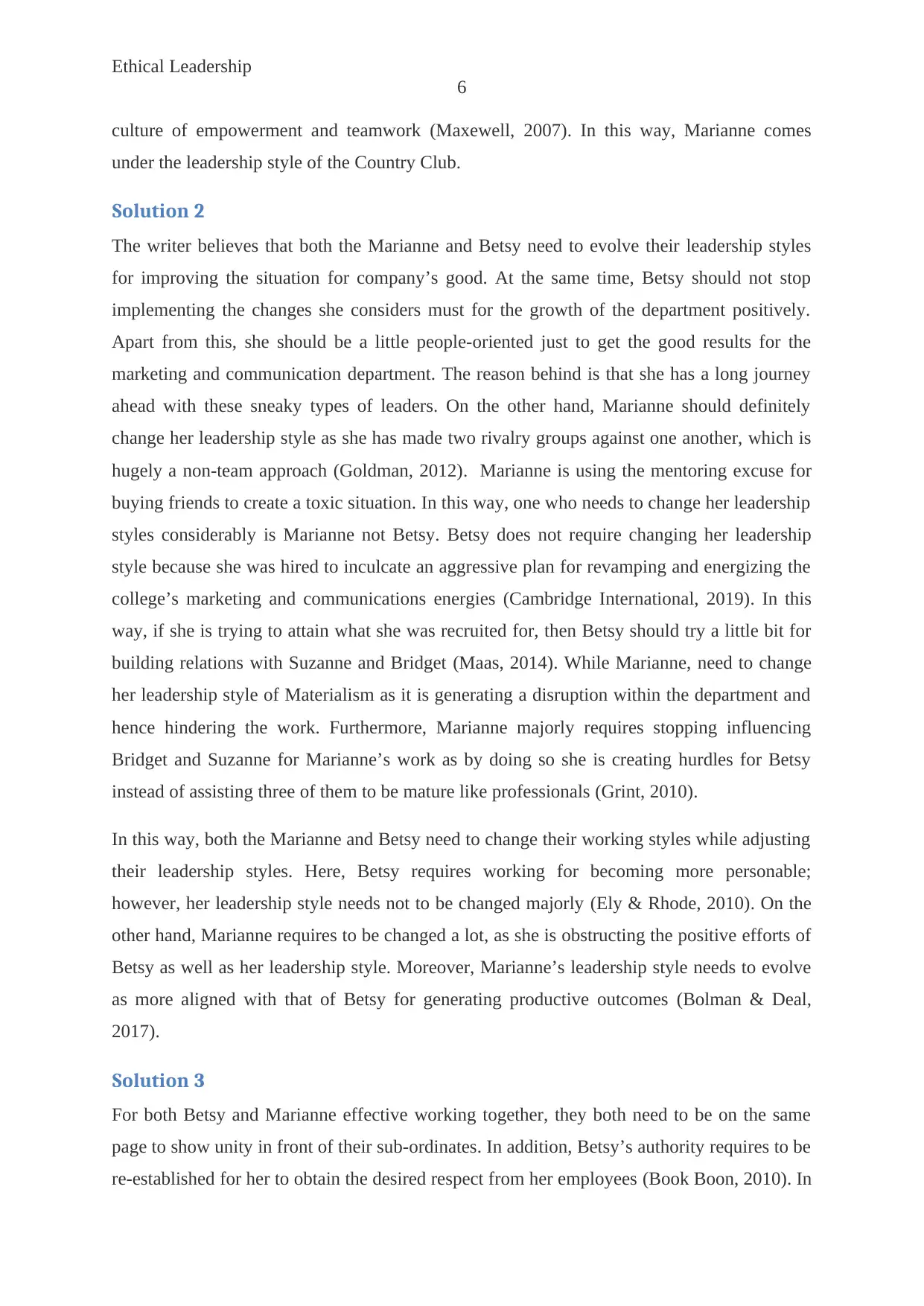
Ethical Leadership
6
culture of empowerment and teamwork (Maxewell, 2007). In this way, Marianne comes
under the leadership style of the Country Club.
Solution 2
The writer believes that both the Marianne and Betsy need to evolve their leadership styles
for improving the situation for company’s good. At the same time, Betsy should not stop
implementing the changes she considers must for the growth of the department positively.
Apart from this, she should be a little people-oriented just to get the good results for the
marketing and communication department. The reason behind is that she has a long journey
ahead with these sneaky types of leaders. On the other hand, Marianne should definitely
change her leadership style as she has made two rivalry groups against one another, which is
hugely a non-team approach (Goldman, 2012). Marianne is using the mentoring excuse for
buying friends to create a toxic situation. In this way, one who needs to change her leadership
styles considerably is Marianne not Betsy. Betsy does not require changing her leadership
style because she was hired to inculcate an aggressive plan for revamping and energizing the
college’s marketing and communications energies (Cambridge International, 2019). In this
way, if she is trying to attain what she was recruited for, then Betsy should try a little bit for
building relations with Suzanne and Bridget (Maas, 2014). While Marianne, need to change
her leadership style of Materialism as it is generating a disruption within the department and
hence hindering the work. Furthermore, Marianne majorly requires stopping influencing
Bridget and Suzanne for Marianne’s work as by doing so she is creating hurdles for Betsy
instead of assisting three of them to be mature like professionals (Grint, 2010).
In this way, both the Marianne and Betsy need to change their working styles while adjusting
their leadership styles. Here, Betsy requires working for becoming more personable;
however, her leadership style needs not to be changed majorly (Ely & Rhode, 2010). On the
other hand, Marianne requires to be changed a lot, as she is obstructing the positive efforts of
Betsy as well as her leadership style. Moreover, Marianne’s leadership style needs to evolve
as more aligned with that of Betsy for generating productive outcomes (Bolman & Deal,
2017).
Solution 3
For both Betsy and Marianne effective working together, they both need to be on the same
page to show unity in front of their sub-ordinates. In addition, Betsy’s authority requires to be
re-established for her to obtain the desired respect from her employees (Book Boon, 2010). In
6
culture of empowerment and teamwork (Maxewell, 2007). In this way, Marianne comes
under the leadership style of the Country Club.
Solution 2
The writer believes that both the Marianne and Betsy need to evolve their leadership styles
for improving the situation for company’s good. At the same time, Betsy should not stop
implementing the changes she considers must for the growth of the department positively.
Apart from this, she should be a little people-oriented just to get the good results for the
marketing and communication department. The reason behind is that she has a long journey
ahead with these sneaky types of leaders. On the other hand, Marianne should definitely
change her leadership style as she has made two rivalry groups against one another, which is
hugely a non-team approach (Goldman, 2012). Marianne is using the mentoring excuse for
buying friends to create a toxic situation. In this way, one who needs to change her leadership
styles considerably is Marianne not Betsy. Betsy does not require changing her leadership
style because she was hired to inculcate an aggressive plan for revamping and energizing the
college’s marketing and communications energies (Cambridge International, 2019). In this
way, if she is trying to attain what she was recruited for, then Betsy should try a little bit for
building relations with Suzanne and Bridget (Maas, 2014). While Marianne, need to change
her leadership style of Materialism as it is generating a disruption within the department and
hence hindering the work. Furthermore, Marianne majorly requires stopping influencing
Bridget and Suzanne for Marianne’s work as by doing so she is creating hurdles for Betsy
instead of assisting three of them to be mature like professionals (Grint, 2010).
In this way, both the Marianne and Betsy need to change their working styles while adjusting
their leadership styles. Here, Betsy requires working for becoming more personable;
however, her leadership style needs not to be changed majorly (Ely & Rhode, 2010). On the
other hand, Marianne requires to be changed a lot, as she is obstructing the positive efforts of
Betsy as well as her leadership style. Moreover, Marianne’s leadership style needs to evolve
as more aligned with that of Betsy for generating productive outcomes (Bolman & Deal,
2017).
Solution 3
For both Betsy and Marianne effective working together, they both need to be on the same
page to show unity in front of their sub-ordinates. In addition, Betsy’s authority requires to be
re-established for her to obtain the desired respect from her employees (Book Boon, 2010). In
Paraphrase This Document
Need a fresh take? Get an instant paraphrase of this document with our AI Paraphraser
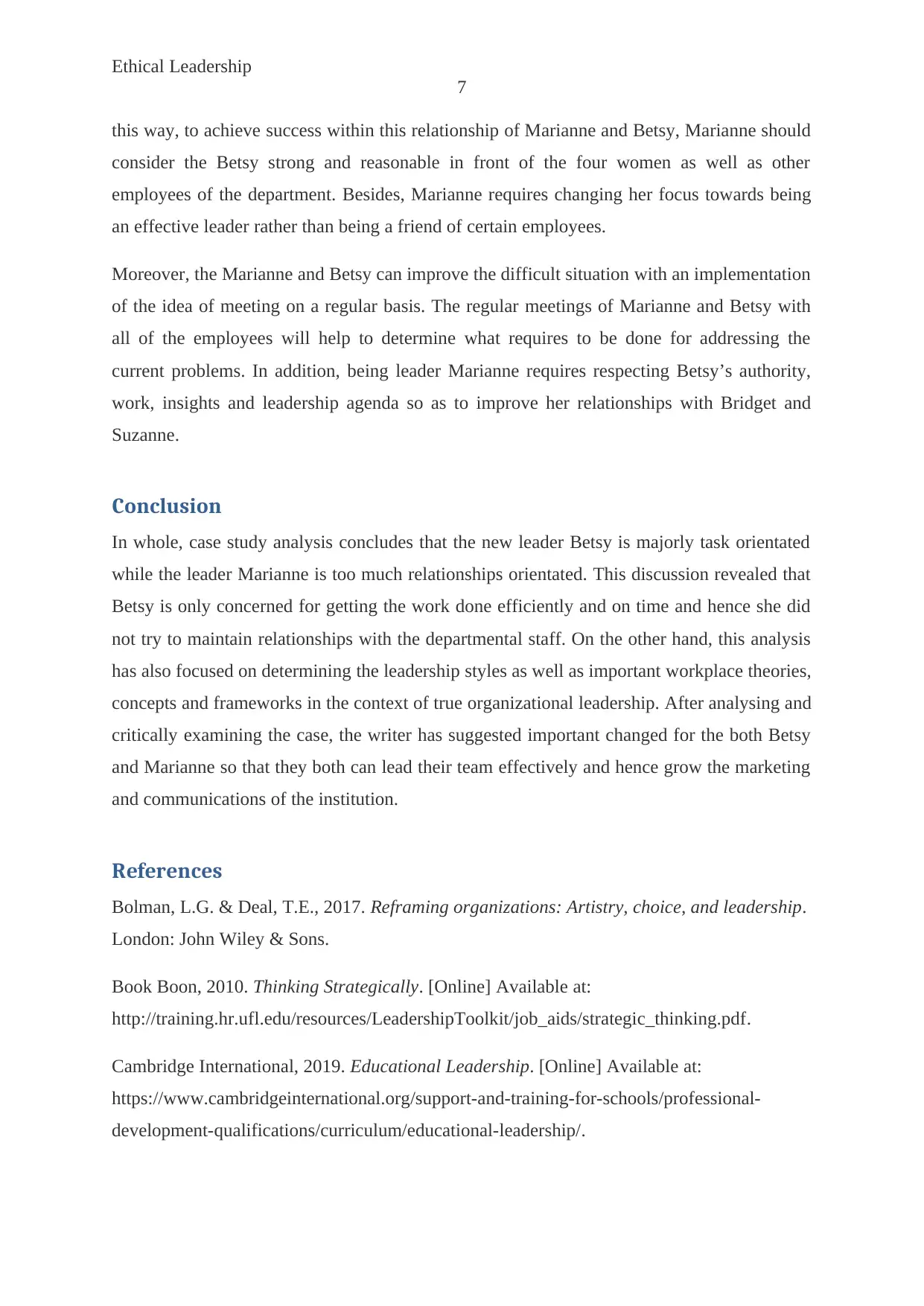
Ethical Leadership
7
this way, to achieve success within this relationship of Marianne and Betsy, Marianne should
consider the Betsy strong and reasonable in front of the four women as well as other
employees of the department. Besides, Marianne requires changing her focus towards being
an effective leader rather than being a friend of certain employees.
Moreover, the Marianne and Betsy can improve the difficult situation with an implementation
of the idea of meeting on a regular basis. The regular meetings of Marianne and Betsy with
all of the employees will help to determine what requires to be done for addressing the
current problems. In addition, being leader Marianne requires respecting Betsy’s authority,
work, insights and leadership agenda so as to improve her relationships with Bridget and
Suzanne.
Conclusion
In whole, case study analysis concludes that the new leader Betsy is majorly task orientated
while the leader Marianne is too much relationships orientated. This discussion revealed that
Betsy is only concerned for getting the work done efficiently and on time and hence she did
not try to maintain relationships with the departmental staff. On the other hand, this analysis
has also focused on determining the leadership styles as well as important workplace theories,
concepts and frameworks in the context of true organizational leadership. After analysing and
critically examining the case, the writer has suggested important changed for the both Betsy
and Marianne so that they both can lead their team effectively and hence grow the marketing
and communications of the institution.
References
Bolman, L.G. & Deal, T.E., 2017. Reframing organizations: Artistry, choice, and leadership.
London: John Wiley & Sons.
Book Boon, 2010. Thinking Strategically. [Online] Available at:
http://training.hr.ufl.edu/resources/LeadershipToolkit/job_aids/strategic_thinking.pdf.
Cambridge International, 2019. Educational Leadership. [Online] Available at:
https://www.cambridgeinternational.org/support-and-training-for-schools/professional-
development-qualifications/curriculum/educational-leadership/.
7
this way, to achieve success within this relationship of Marianne and Betsy, Marianne should
consider the Betsy strong and reasonable in front of the four women as well as other
employees of the department. Besides, Marianne requires changing her focus towards being
an effective leader rather than being a friend of certain employees.
Moreover, the Marianne and Betsy can improve the difficult situation with an implementation
of the idea of meeting on a regular basis. The regular meetings of Marianne and Betsy with
all of the employees will help to determine what requires to be done for addressing the
current problems. In addition, being leader Marianne requires respecting Betsy’s authority,
work, insights and leadership agenda so as to improve her relationships with Bridget and
Suzanne.
Conclusion
In whole, case study analysis concludes that the new leader Betsy is majorly task orientated
while the leader Marianne is too much relationships orientated. This discussion revealed that
Betsy is only concerned for getting the work done efficiently and on time and hence she did
not try to maintain relationships with the departmental staff. On the other hand, this analysis
has also focused on determining the leadership styles as well as important workplace theories,
concepts and frameworks in the context of true organizational leadership. After analysing and
critically examining the case, the writer has suggested important changed for the both Betsy
and Marianne so that they both can lead their team effectively and hence grow the marketing
and communications of the institution.
References
Bolman, L.G. & Deal, T.E., 2017. Reframing organizations: Artistry, choice, and leadership.
London: John Wiley & Sons.
Book Boon, 2010. Thinking Strategically. [Online] Available at:
http://training.hr.ufl.edu/resources/LeadershipToolkit/job_aids/strategic_thinking.pdf.
Cambridge International, 2019. Educational Leadership. [Online] Available at:
https://www.cambridgeinternational.org/support-and-training-for-schools/professional-
development-qualifications/curriculum/educational-leadership/.
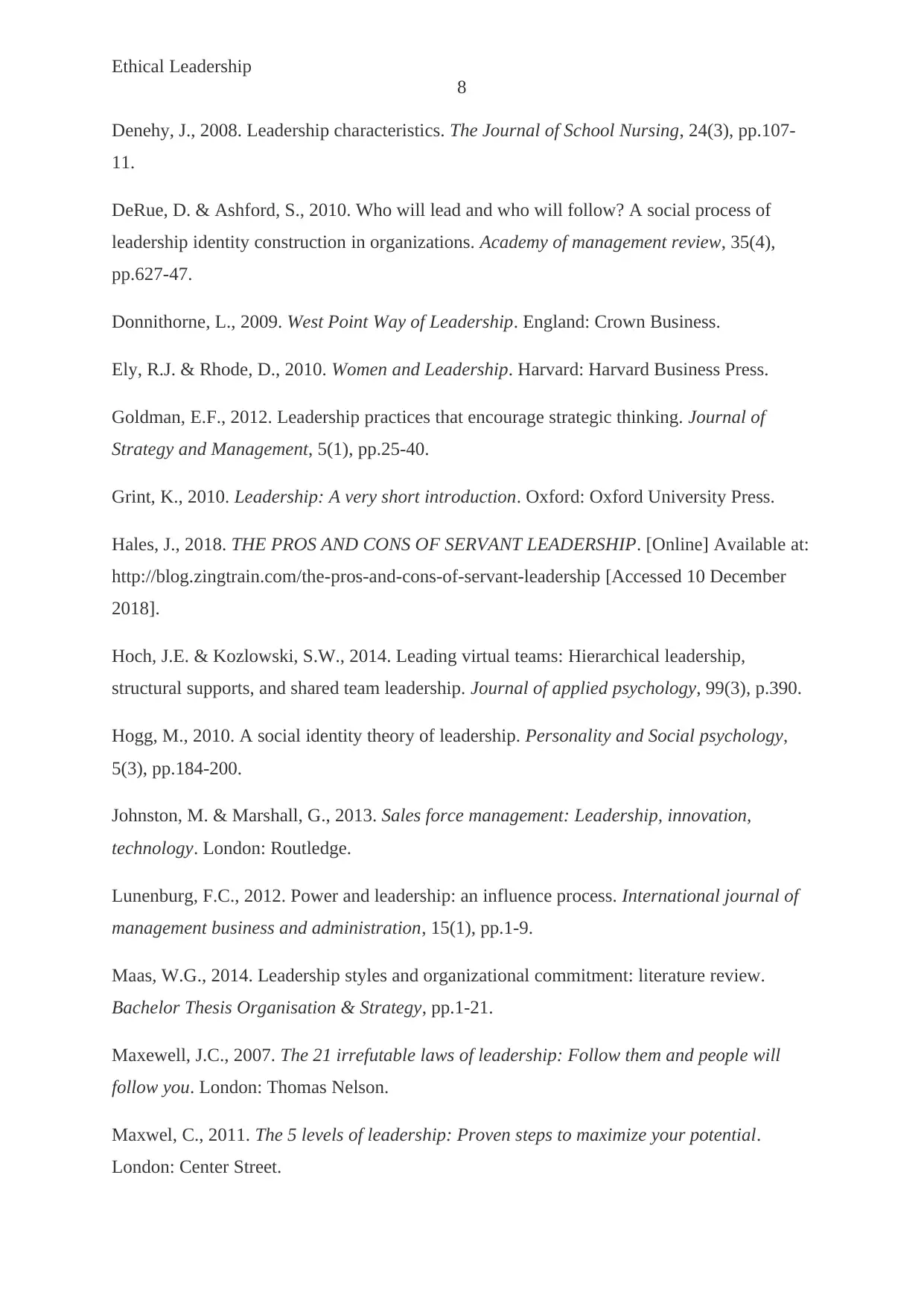
Ethical Leadership
8
Denehy, J., 2008. Leadership characteristics. The Journal of School Nursing, 24(3), pp.107-
11.
DeRue, D. & Ashford, S., 2010. Who will lead and who will follow? A social process of
leadership identity construction in organizations. Academy of management review, 35(4),
pp.627-47.
Donnithorne, L., 2009. West Point Way of Leadership. England: Crown Business.
Ely, R.J. & Rhode, D., 2010. Women and Leadership. Harvard: Harvard Business Press.
Goldman, E.F., 2012. Leadership practices that encourage strategic thinking. Journal of
Strategy and Management, 5(1), pp.25-40.
Grint, K., 2010. Leadership: A very short introduction. Oxford: Oxford University Press.
Hales, J., 2018. THE PROS AND CONS OF SERVANT LEADERSHIP. [Online] Available at:
http://blog.zingtrain.com/the-pros-and-cons-of-servant-leadership [Accessed 10 December
2018].
Hoch, J.E. & Kozlowski, S.W., 2014. Leading virtual teams: Hierarchical leadership,
structural supports, and shared team leadership. Journal of applied psychology, 99(3), p.390.
Hogg, M., 2010. A social identity theory of leadership. Personality and Social psychology,
5(3), pp.184-200.
Johnston, M. & Marshall, G., 2013. Sales force management: Leadership, innovation,
technology. London: Routledge.
Lunenburg, F.C., 2012. Power and leadership: an influence process. International journal of
management business and administration, 15(1), pp.1-9.
Maas, W.G., 2014. Leadership styles and organizational commitment: literature review.
Bachelor Thesis Organisation & Strategy, pp.1-21.
Maxewell, J.C., 2007. The 21 irrefutable laws of leadership: Follow them and people will
follow you. London: Thomas Nelson.
Maxwel, C., 2011. The 5 levels of leadership: Proven steps to maximize your potential.
London: Center Street.
8
Denehy, J., 2008. Leadership characteristics. The Journal of School Nursing, 24(3), pp.107-
11.
DeRue, D. & Ashford, S., 2010. Who will lead and who will follow? A social process of
leadership identity construction in organizations. Academy of management review, 35(4),
pp.627-47.
Donnithorne, L., 2009. West Point Way of Leadership. England: Crown Business.
Ely, R.J. & Rhode, D., 2010. Women and Leadership. Harvard: Harvard Business Press.
Goldman, E.F., 2012. Leadership practices that encourage strategic thinking. Journal of
Strategy and Management, 5(1), pp.25-40.
Grint, K., 2010. Leadership: A very short introduction. Oxford: Oxford University Press.
Hales, J., 2018. THE PROS AND CONS OF SERVANT LEADERSHIP. [Online] Available at:
http://blog.zingtrain.com/the-pros-and-cons-of-servant-leadership [Accessed 10 December
2018].
Hoch, J.E. & Kozlowski, S.W., 2014. Leading virtual teams: Hierarchical leadership,
structural supports, and shared team leadership. Journal of applied psychology, 99(3), p.390.
Hogg, M., 2010. A social identity theory of leadership. Personality and Social psychology,
5(3), pp.184-200.
Johnston, M. & Marshall, G., 2013. Sales force management: Leadership, innovation,
technology. London: Routledge.
Lunenburg, F.C., 2012. Power and leadership: an influence process. International journal of
management business and administration, 15(1), pp.1-9.
Maas, W.G., 2014. Leadership styles and organizational commitment: literature review.
Bachelor Thesis Organisation & Strategy, pp.1-21.
Maxewell, J.C., 2007. The 21 irrefutable laws of leadership: Follow them and people will
follow you. London: Thomas Nelson.
Maxwel, C., 2011. The 5 levels of leadership: Proven steps to maximize your potential.
London: Center Street.
⊘ This is a preview!⊘
Do you want full access?
Subscribe today to unlock all pages.

Trusted by 1+ million students worldwide
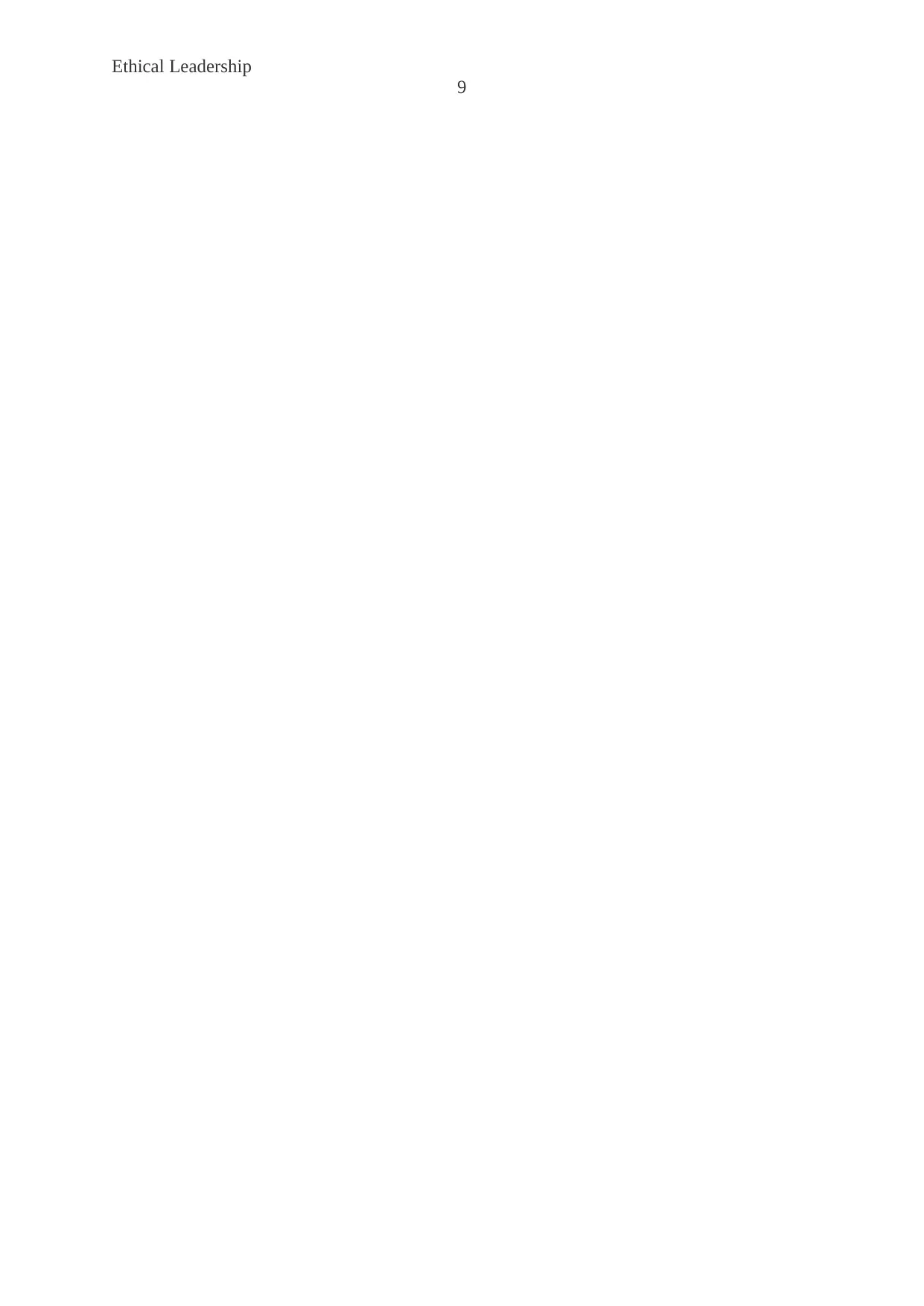
Ethical Leadership
9
9
1 out of 10
Related Documents
Your All-in-One AI-Powered Toolkit for Academic Success.
+13062052269
info@desklib.com
Available 24*7 on WhatsApp / Email
![[object Object]](/_next/static/media/star-bottom.7253800d.svg)
Unlock your academic potential
Copyright © 2020–2025 A2Z Services. All Rights Reserved. Developed and managed by ZUCOL.





